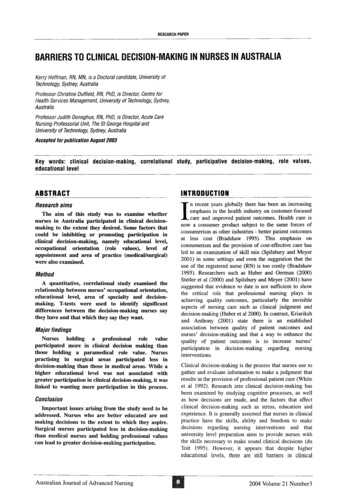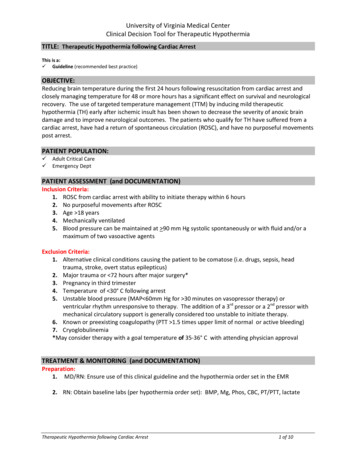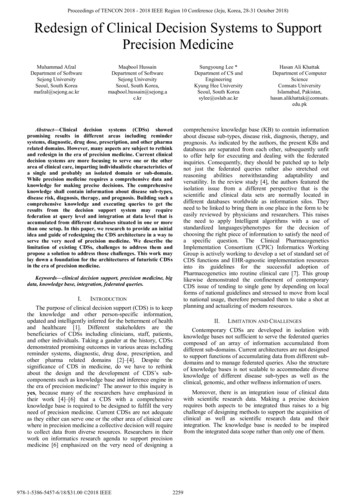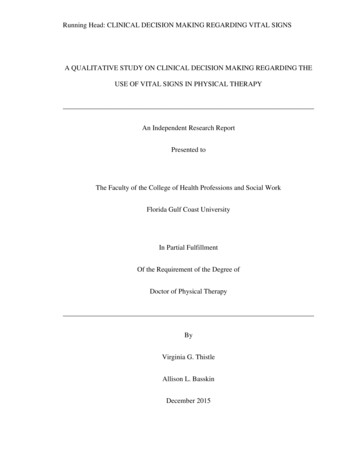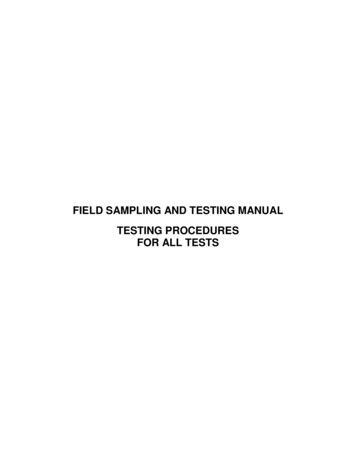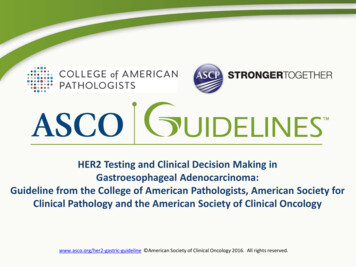
Transcription
HER2 Testing and Clinical Decision Making inGastroesophageal Adenocarcinoma:Guideline from the College of American Pathologists, American Society forClinical Pathology and the American Society of Clinical Oncologywww.asco.org/her2-gastric-guideline American Society of Clinical Oncology 2016. All rights reserved.
Introduction Gastroesophageal adenocarcinoma (GEA) is estimated to represent up to 43,280 cancer casesin the US in 2016,1 and represents the eighth (esophageal) and fifth (stomach) most commoncancers worldwide.2 In 2010, results of an open-label, international, phase 3 randomized controlled trial(Trastuzumab for Gastric Cancer, ToGA), showed that the anti-HER2 humanized monoclonalantibody trastuzumab (Herceptin) statistically significantly prolonged overall survivalcompared with chemotherapy alone in patients with HER2–positive advanced GEA.3 In 2007, a joint expert panel convened by the American Society of Clinical Oncology (ASCO)and the College of American Pathologists (CAP) met to develop guidelines for when and howto test for HER2 in patients with breast cancer, which is amplified and/or overexpressed inup to 30% of cases.4 Because there are important distinct differences in HER2 expression, scoring, and outcomesin GEA relative to breast carcinoma, the need for HER2 guidelines (that include critical clinicaland laboratory considerations) was recognized.www.asco.org/her2-gastric-guideline American Society of Clinical Oncology 2016. All rights reserved.
CAP/ASCP/ASCO GuidelineDevelopment MethodologyThe process for this guideline included: a systematic literature review an expert panel provided critical review and evidence interpretation toinform guideline recommendations final guideline approval by the CAP independent review panel, ASCPSpecial Review Panel, and ASCO CPGCThe full guideline methodology supplement can be found /her2-gastric-guideline American Society of Clinical Oncology 2016. All rights reserved.
Clinical QuestionsWhat is the optimal testing algorithm for the assessment ofHER2 status in patients with GEA?What strategies can help ensure optimal performance,interpretation, and reporting of established assays in patientswith GEA?www.asco.org/her2-gastric-guideline American Society of Clinical Oncology 2016. All rights reserved.
Target Population and AudienceTarget PopulationPatients with Gastroesophageal AdenocarcinomaTarget AudienceMedical and surgical oncologists; oncology nurses and physician assistants;pathologists; general practitioners; and patientswww.asco.org/her2-gastric-guideline American Society of Clinical Oncology 2016. All rights reserved.
Summary of RecommendationsCLINICAL QUESTION 1What is the optimal testing algorithm for the assessment of HER2 status in patients with GEA?Recommendation 1.1In patients with advanced GEA who are potential candidates for HER2 targeted therapy, thetreating clinician should request HER2 testing on tumor tissue (Type: Evidence based; Quality ofevidence: High; Strength of recommendation: Strong).Recommendation 1.2Treating clinicians or pathologists should request HER2 testing on tumor tissue in the biopsy orresection specimens (primary or metastasis) preferably prior to the initiation of trastuzumabtherapy if such specimens are available and adequate. HER2 testing on FNA specimens (cellblocks) is an acceptable alternative (Type: Evidence based; Quality of evidence:Moderate/Intermediate; Strength of recommendation: Recommendation/Moderate).Recommendation 1.3Treating clinicians should offer combination chemotherapy and HER2-targeted therapy as theinitial treatment for appropriate patients with HER2 positive tumors who have advanced GEA(Type: Evidence based; Quality of evidence: Moderate/Intermediate; Strength ofrecommendation: Strong).www.asco.org/her2-gastric-guideline American Society of Clinical Oncology 2016. All rights reserved.
Summary of RecommendationsCLINICAL QUESTION 2What strategies can help ensure optimal performance, interpretation, and reporting ofestablished assays in patients with GEA?Recommendation 2.1Laboratories/pathologists must specify the antibodies and probes used for the test and ensurethat assays are appropriately validated for HER2 IHC and ISH on GEA specimens (Type: Evidencebased; Quality of evidence: Moderate/Intermediate; Strength of recommendation: Strong).Recommendation 2.2When GEA HER2 status is being evaluated, laboratories/pathologists should perform/order IHCtesting first followed by ISH when IHC result is 2 (equivocal). Positive (3 ) or negative (0 or 1 )HER2 IHC results do not require further ISH testing (Type: Evidence based; Quality of evidence:High; Strength of recommendation: Strong).Recommendation 2.3Pathologists should use the Ruschoff/Hofmann method in scoring HER2 IHC and ISH results forGEA (Type: Evidence based; Quality of evidence: Moderate/Intermediate; Strength ofrecommendation: Strong).www.asco.org/her2-gastric-guideline American Society of Clinical Oncology 2016. All rights reserved.
Summary of RecommendationsRecommendation 2.4Pathologists should select the tissue block with the areas of lowest grade tumor morphology inbiopsy and resection specimens. More than one tissue block may be selected if differentmorphologic patterns are present (Type: Evidence based; Quality of evidence:Moderate/Intermediate; Strength of recommendation: Recommendation/Moderate).Recommendation 2.5Laboratories should report HER2 test results in GEA specimens in accordance with the CAPbiomarker “Template for Reporting Results of HER2 (ERBB2) Biomarker Testing of SpecimensFrom Patients With Adenocarcinoma of the Stomach or Esophagogastric Junction”5 (Type:Evidence based; Quality of evidence: Moderate/Intermediate; Strength of uideline American Society of Clinical Oncology 2016. All rights reserved.
Summary of RecommendationsRecommendation 2.6Pathologists should identify areas of invasive adenocarcinoma and also mark areas with strongestintensity of HER2 expression by IHC in GEA specimen for subsequent ISH scoring when required(Type: Evidence based; Quality of evidence: Moderate/Intermediate; Strength ofrecommendation: Strong).Recommendation 2.7Laboratories must incorporate GEA HER2 testing methods into their overall laboratory qualityimprovement program, establishing appropriate quality improvement monitors as needed toassure consistent performance in all steps of the testing and reporting process. In particular,laboratories performing GEA HER2 testing should participate in a formal proficiency testingprogram, if available, or an alternative proficiency assurance activity (Type: Evidence based;Quality of evidence: Moderate/Intermediate; Strength of recommendation: Strong).Recommendation 2.8There is insufficient evidence to recommend for or against genomic testing in GEA patients at thistime.www.asco.org/her2-gastric-guideline American Society of Clinical Oncology 2016. All rights reserved.
HER2 immunochemistry showing representative cases for scoring.(A) Negative 0: No reactivity, specifically no membranous reactivity is seen in any of the tumor cells. Any cytoplasmic staining is disregarded for scoringpurposes; (B) Negative 1 : Tumor cells with faint/barely perceptible membranous staining; (C) Equivocal 2 : Tumor cells with weak to moderate complete,basolateral and lateral membranous staining. Columnar cells that are sectioned tangentially tend to show a complete membranous staining pattern; (D)Positive 3 : Tumor cells with a strong complete, basolateral and lateral membranous reactivity. Also note that cells showing a complete membranousstaining pattern are often tangentially sectioned columnar cells.www.asco.org/her2-gastric-guideline American Society of Clinical Oncology 2016. All rights reserved.
HER2 and CEP 17 fluorescence in situ hybridization (FISH) shows scores ofrepresentative cases(A) Not amplified: Ratio 1.0. Mean number of HER2 signals per cell is 1.9; mean number of CEP 17 signals per cell is 1.8; (B) Notamplified: Ratio 1.3. Mean number of HER2 signals per cell is 3.4; mean number of CEP 17 signals per cell is 2.7. Segmentalduplication (or polysomy) likely accounts for signal numbers over 2 per cell; (C) Amplified: Ratio 3.0. Mean number of HER2 signalsper cell is 5.2; mean number of CEP 17 signals per cell is 1.7.www.asco.org/her2-gastric-guideline American Society of Clinical Oncology 2016. All rights reserved.
Conclusion GEA continues to be a major healthcare burden throughout theworld. Advanced GEA that is not amenable to effective local therapyremains incurable and patients have limited therapeutic options. Other than HER2, there is no biomarker available for selection oftherapy for patients with advanced GEA. Trastuzumab is the only approved HER2-directed therapy that hasresulted in modest but statistically significant prolongation ofoverall survival of HER2 positive GEA patients.www.asco.org/her2-gastric-guideline American Society of Clinical Oncology 2016. All rights reserved.
Additional ResourcesMore information, including a Data Supplement, aMethodology Supplement, slide sets, and clinical toolsand resources, is available atwww.asco.org/her2-gastric-guidelinePatient information is available at www.cancer.netwww.asco.org/her2-gastric-guideline American Society of Clinical Oncology 2016. All rights reserved.
ASCO Guideline Panel MembersMemberAffiliationAngela Bartley, co-chairSt. Joseph Mercy Hospital, Ann Arbor, MIMary Kay Washington, co-chairVanderbilt-Ingram Cancer Center, Nashville, TNJaffer Ajani, co-chairMD Anderson Cancer Center, Houston, TXSanjay KakarUniversity of California, San Francisco, CALaura TangMemorial Sloan Kettering Cancer Center, New York, NYMegan TroxellOregon Health & Science University, Portland, ORCatherine StreutkerSt. Michael's Hospital, University of Toronto, Toronto, CanadaDhanpat JainYale University School of Medicine, New Haven, CTMargaret L. GulleyUniversity of North Carolina, Chapel Hill, NCHelen J MackayPrincess Margaret Cancer Centre, Toronto, CanadaAlfredo CarratoRamony Cajal University Hospital, Madrid, SpainAl B. Benson IIINorthwestern University, Chicago, ILwww.asco.org/her2-gastric-guideline American Society of Clinical Oncology 2016. All rights reserved.
References1. American Cancer Society: Cancer facts & figures ocuments/document/acspc-047079.pdf (Accessed July 8, 2016)2. World Cancer Research Fund International: Cancer facts & figures - Worldwide data. ide-data (Accessed June 28, 2016)3. Bang YJ, Van Cutsem E, Feyereislova A, et al: Trastuzumab in combination with chemotherapy versus chemotherapy alone fortreatment of HER2-positive advanced gastric or gastro-oesophageal junction cancer (ToGA): a phase 3, open-label, randomisedcontrolled trial. Lancet 376:687-697, 20104. Wolff AC, Hammond ME, Schwartz JN, et al: American Society of Clinical Oncology/College of American Pathologists guidelinerecommendations for human epidermal growth factor receptor 2 testing in breast cancer. Arch Pathol Lab Med 131:18-43, 20075. Bartley AN, Christ J, Fitzgibbons PL, et al: Template for reporting results of HER2 (ERBB2) biomarker testing of specimens frompatients with adenocarcinoma of the stomach or esophagogastric junction. Arch Pathol Lab Med 139:618-620, 2015www.asco.org/her2-gastric-guideline American Society of Clinical Oncology 2016. All rights reserved.
DisclaimerThe Clinical Practice Guidelines and other guidance published herein are provided by the AmericanSociety of Clinical Oncology, Inc. (ASCO) to assist providers in clinical decision making. The informationherein should not be relied upon as being complete or accurate, nor should it be considered as inclusiveof all proper treatments or methods of care or as a statement of the standard of care. With the rapiddevelopment of scientific knowledge, new evidence may emerge between the time information isdeveloped and when it is published or read. The information is not continually updated and may notreflect the most recent evidence. The information addresses only the topics specifically identifiedtherein and is not applicable to other interventions, diseases, or stages of diseases. This informationdoes not mandate any particular course of medical care. Further, the information is not intended tosubstitute for the independent professional judgment of the treating provider, as the information doesnot account for individual variation among patients. Recommendations reflect high, moderate, or lowconfidence that the recommendation reflects the net effect of a given course of action. The use ofwords like “must,” “must not,” “should,” and “should not” indicates that a course of action isrecommended or not recommended for either most or many patients, but there is latitude for thetreating physician to select other courses of action in individual cases. In all cases, the selected courseof action should be considered by the treating provider in the context of treating the individual patient.Use of the information is voluntary. ASCO provides this information on an “as is” basis and makes nowarranty, express or implied, regarding the information. ASCO specifically disclaims any warranties ofmerchantability or fitness for a particular use or purpose. ASCO assumes no responsibility for any injuryor damage to persons or property arising out of or related to any use of this information, or for anyerrors or omissions.www.asco.org/her2-gastric-guideline American Society of Clinical Oncology 2016. All rights reserved.
a systematic literature review an expert panel provided critical review and evidence interpretation to inform guideline recommendations final guideline approval by the CAP independent review panel, ASCP
